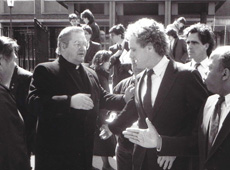State papers suggest Ian Paisley was more moderate than it seemed
Posted By: January 03, 2017
Irish Examiner. Cork. Tuesday, January 03, 2017
Outwardly, Ian Paisley was vehemently against the Anglo-Irish Agreement, but state papers hint at a different attitude behind the scenes writes Ryle Dwyer
Ian Paisley during elections in 1986 at the height of his “Ulster Says No” campaign.
Picture: Pacemaker Belfast
Ian Paisley seemed to lead the vocal campaign against the Anglo-Irish Agreement in Northern Ireland, but state papers just released hint strongly of a somewhat different attitude behind the scenes, although he could hardly have been more acerbic in his public pronouncements.
During a sermon in his church, for instance, he denounced Margaret Thatcher in trenchant terms. “O God,” he said, “we pray this night that Thou wouldst deal with the Prime Minister of our country. O God in wrath take vengeance upon this wicked, treacherous, lying woman.”
Behaving as an archetypal demagogue, he represented the visceral antagonism of Unionists outside City Hall in Belfast before a quarter-of-a-million people in November 1985. He denounced Thatcher for saying the Republic of Ireland must have a say in Northern Ireland. “We say never, never, never, never,” roared Paisley.
Unionists were considering a general strike on the lines of the Workers’ Strike that brought down the Sunningdale Agreement of 1974. UUP leader James Molyneaux was in favor, but Paisley advised against it.
Paisley and Molyneaux met with Thatcher in London on February 25, 1986. Though she refused to suspend the Anglo-Irish Agreement, she was clearly rattled by the intensity of the unionist opposition, so she offered new arrangements to allow the unionists to make their views known to her government, as well as consultations about the handling of Northern Ireland business at Westminster.
Molyneaux and Paisley agreed to reflect on her suggestions, but Paisley was in for a stormy reception when he got home, according to information secretly supplied to David Donoghue of the Anglo-Irish Secretariat at Maryfield.
Paisley was met at his home that evening by Peter Robinson, and representatives of the Ulster Defence Association (UDA), Ulster Volunteer Force (UVF), Apprentice Boys, and the Orange Order.
The meeting began “in friendly terms but quickly turned acrimonious,” according to Donoghue’s informant.
“Paisley felt that he and Molyneaux had brought back something from London which could be represented as a concession by Mrs Thatcher.”
“What you’ve got is not enough,” Robinson insisted. “These boys want a strike,” he said, alluding to the others present. A series of heated exchanges ensued, with Paisley opposing a strike, while Robinson was insisting on one. The others, apparently, agreed with Robinson, because they let him “do most of the talking for them”.
“There has been some speculation that he is pushing the strike idea in an effort to wrest the DUP leadership from Paisley,” Donoghue added.
Robinson was apparently planning to have East Belfast as the “model area” for the strike. It would easy to cut off the area because there was only a couple of main arteries, and the workforce in the three major plants — Shorts, Harland & Wolff, and Sirocco — had traditionally been sympathetic to such strike action.
The strike on March 3, 1986, was deemed “A Day of Action”. About 90% of the civil servants reportedly turned up for work, but as the day went on there were complaints of intimidations and violence from various areas. The British Army remained out of sight, and there were numerous reports of the RUC refusing to intervene to stop intimidation.
Downtown Radio reported rioting in Belfast in the mid-afternoon, following a rally at City Hall addressed by Peter Robinson. Up to 50 youths overturned a lorry and set it on fire. A car was also set on fire on a nearby street. Belfast airport was completely closed by road blocks. Saracen’s factory in Lurgan was attacked, and Radio Ulster reported a fire at the factory.
The intimidation was highlighted in the British media, and this seriously diluted the effectiveness of the strike in the eyes of the British public. Loyalists lost media sympathy and also political support in sections of the Conservative Party.
Peter Robinson downplayed the violence. “The strike wasn’t violent at all,” he declared in an interview. “Nobody was killed during that day, nobody was seriously injured,” he added. “There was some cars burnt, there were some lorries burnt, there were some premises damaged.” By Northern Ireland standards, the violence “was really minimal”, he insisted.
Michael Lillis reported to the Department of Foreign Affair from Belfast on April 30 that Northern Secretary Tom King believed that Molyneaux and Paisley were serious about their desire for peace and compromise. King thought they were alarmed at the extent to which they had initially sowed extreme opposition to the agreement.
“King believes that only the fragile survival of Molyneaux and Paisley stands between him and a chaotic summer. “Paisley was in the forefront of the campaign against the agreement,” Thatcher later wrote.
“But far more worrying was the fact that behind him stood harder and more sinister figures, who might all too easily cross the line from civil disobedience to violence.”










